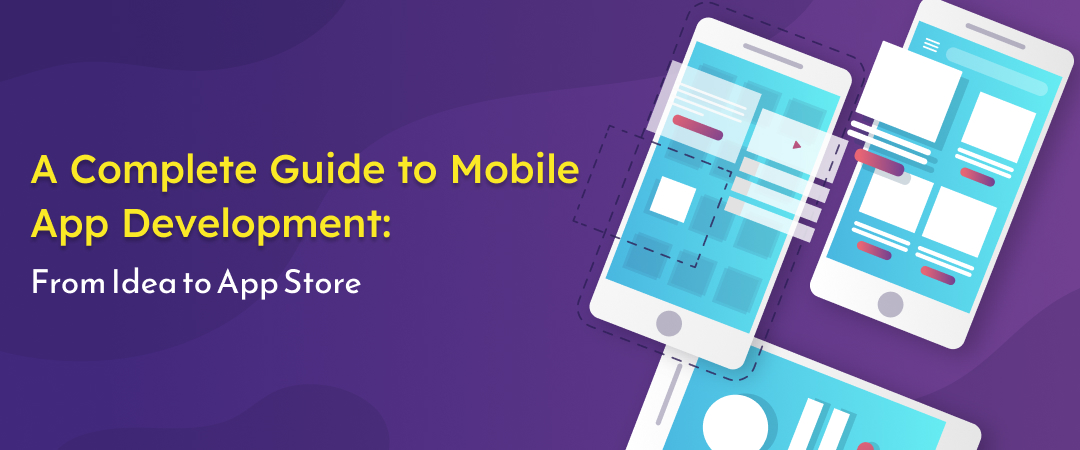
From Idea to App Store – A Comprehensive Guide to Mobile App Development

Mobile application development has been in vogue for some time, and all sectors are utilizing the technology’s benefits. With smartphones being used by everyone, developing a mobile app to serve customers better becomes a priority. It is proven that more than 70% of users’ time is spent accessing smartphones globally.
A report predicts that the market for mobile app development will increase at a CAGR of 9.27% from 2022 to 2026, reaching a market size of $614.40 billion.
What is Mobile App Development?
Mobile app development is the process involved in creating software that runs efficiently on smartphones and digital assistants. These programmers can be pre-installed on the device, downloaded from an app store, or accessible via a mobile web browser.
The process’s first stages of development include:
- Creating applications and designs by writing code.
- Installing the created software and starting backend services to use an API to retrieve data
- Testing the app on the chosen devices is the last step.
Mobile app development is like developing other software. Their divergence point is the mobile app’s ability to leverage a device’s built-in features like GPS, camera, microphone, and Bluetooth on a smartphone.
Mobile Apps Development Platform:
This platform is an infrastructure created to facilitate developers by providing all the required tools for application development. The developers use this platform to reduce their risk of data loss, time and financial loss, and incorrect data classification.
The most prominent platforms are:
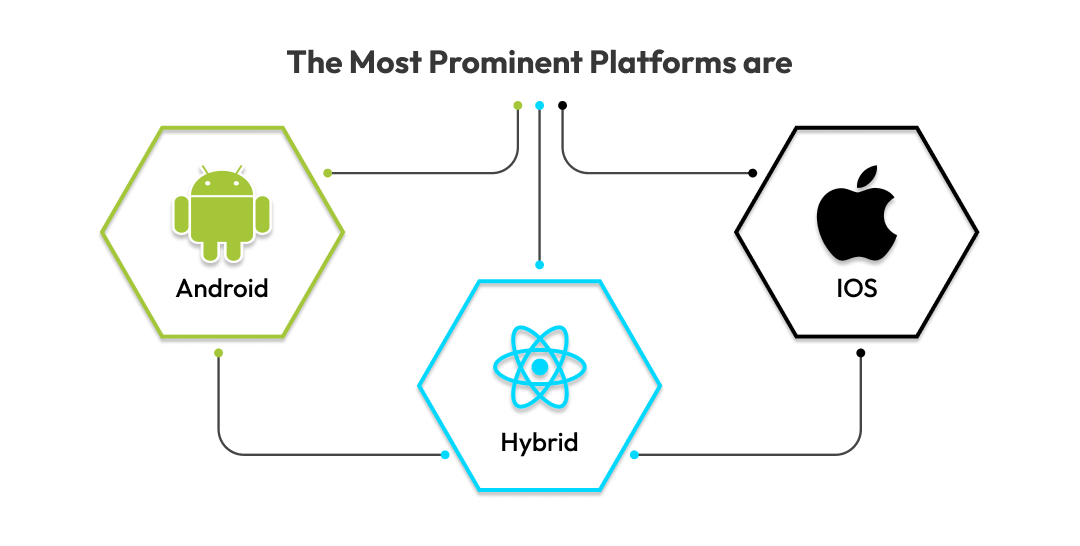
Android:
- Designed for smartphones and tablets.
- It allows developers to download, customize and distribute the source code without any cost.
- Support multiple apps running concurrently on a mobile device and help UI customization during the development stage.
- Holds 44.46% of the mobile OS market share in the USA as of July 2022.
iOS:
- It owns exclusive rights to products made by Apple, such as iPhones or iPad.
- Developers can purchase the iOS software development kit to create a mobile app for apple devices and make it available through the App stores.
- Holds 55.22% of the mobile iOS market share in the USA as of July 2022.
Hybrid:
- Infuses the qualities of both native and web programming into a single application.
- On a single platform, developers can create numerous applications for different iOS.
- Code is embedded into the native application.
- Helps to build a similar application for each iOS type.
What are the different types of mobile app development:
With our understanding of mobile app development and its platforms, let us know about the different types.
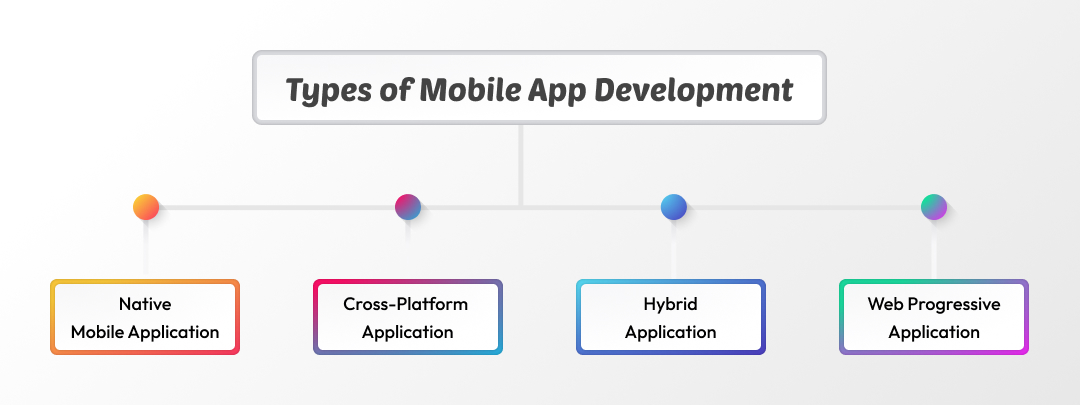
Native Mobile Applications
Native apps are installed directly on a mobile device. It is available for download from the Google Play Store or the Apple App Store. They can work even without an internet connection. Tools and Technologies used are Java, Kotlin, and Python.
Benefits:
- Rapid speed and enhanced user experience as it is built directly on iOS’s platform.
- Direct access to the device’s APIs.
- Easily compatible with the existing features of the device it is installed on.
Drawbacks:
- The process of development is time-consuming and money-consuming.
- Android and iOS require different coding.
- They need to be updated frequently because bugs can occur.
Cross-platform Applications
The cross-platform app creates a common code application for both Android and iOS. Cross-platform app processes are a little slower because an additional abstraction layer and rendering process are required. Cross-platform applications maintain the same user experience.
Tools and Technologies used are Xamarin, NativeScript, and Node.js.
Benefits:
- Single or the same code utilized for multiple platforms
- The development timeline is relatively shorter when compared to the native counterpart.
- It is more affordable and has a larger audience reach.
Drawbacks:
- The app’s new feature deployment process takes longer.
- Debugging is done more frequently due to performance and compatibility concerns with specific operating systems.
- With some operating systems, security concerns are a real problem.
Hybrid Mobile Applications
Hybrid apps and cross-platform are not identical though code is written for a hybrid app to work on both platforms (Android and iOS). Hybrid development is simple to build with only a rudimentary technical understanding and web development knowledge. Technology and tools include Objective C, Ionic, HTML5, and others. Popular apps are Gmail, Just Watch and Evernote.
Benefits:
- The development process is rapid.
- It has a similar feel to a native app.
- Cost optimization is achieved by building and maintaining hybrid apps.
Drawbacks:
- Only limited features are offered.
- Non-synchronization with older devices hinders performance.
- Non-compatible with certain types of apps.
Progressive Web Application (PWA)
As the name implies, Progressive Web Applications are deployed via the web, as opposed to their counterparts, which are installed on the user’s device.
It has the same functionality and experience as a native app. Push notification is enabled to users, triggered through the web browser.
However, compared to native app features, there are only limited features in this app. Technology and tools include JavaScript, Ruby, and CSS.
Popular apps are MakeMyTrip, Slack and Google Docs.
Benefits:
- Development and maintenance are cost-effective.
- The installation process is faster and easier on all types of devices.
- Compatible function-wise from all places due to cross-platform support.
- Efficiency in performance presents a better user experience.
Drawbacks:
- As it is a web-based application, access from app stores is denied.
- Limited functionality requiring Bluetooth or NFC denies users a rich experience.
Why do businesses need mobile apps?
With mobile app development not showing any signs of retreating, it is anticipated that by the end of 2023, the total number of mobile app downloads is estimated to be 299 billion worldwide.
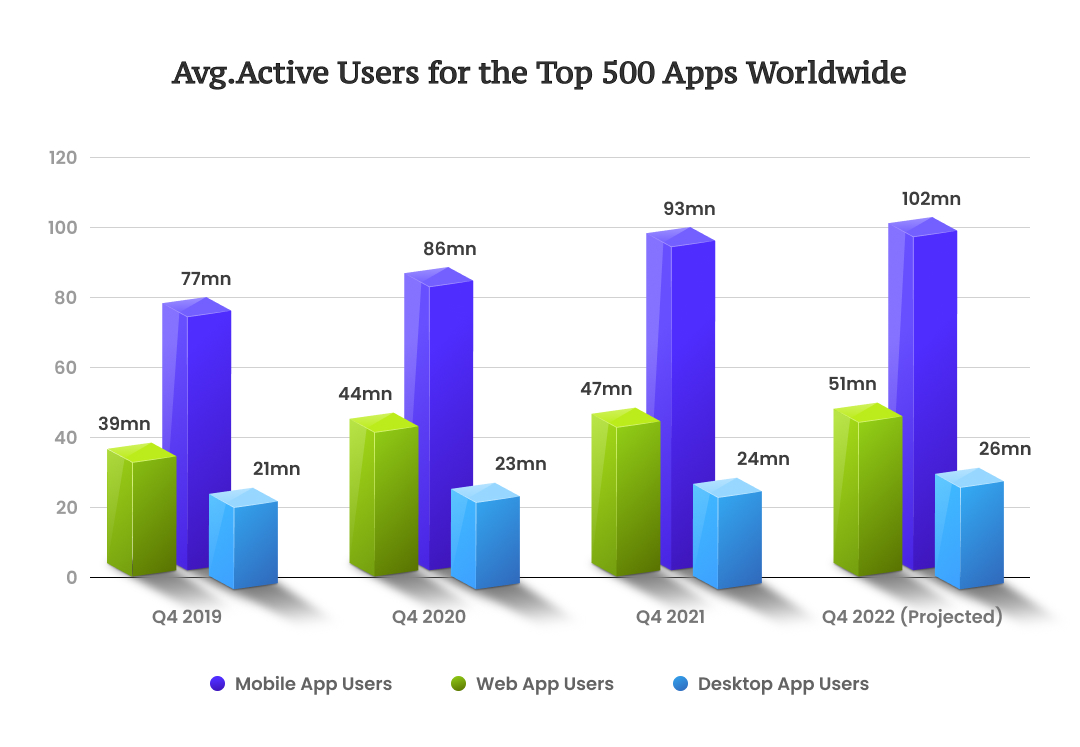
Mobile phones are indispensable today, and even a few activities are conducted through them.
Businesses develop mobile apps to engage customers and make their products or services easily accessible.
It acts as a marketing tool to advertise the product to far-away territories. It is cost-effective and offers two-way communication between the customers (reviews and ratings) and the firm (updates, offers). From the sales perspective, surplus revenue is generated through customer engagement and positive reviews.
Let us elaborate on a few:
Customers-centric:
The breakthrough in technology has provided both customers and businesses with equal opportunities to utilize it. Previously, customers would flock to shops for shopping, whereas today, businesses need to display their products and services on websites. Mobile applications are critical in enabling businesses to sell their products based on the needs and uses of their customers. The mobile apps focus on customers by providing a better user experience, adding features, and engaging in various promotional activities to keep customers engaged.
Promotes brand image:
The amount of time spent on a mobile device or smartphone has increased dramatically among people of all ages and social classes. But they access only a limited number of apps based on their requirements. Once a user downloads your app, it becomes more visible on their screen. This is an indirect promotion of your company’s brand to customers.
Competitive edge
It is a bygone era, where revenue is generated through websites and digital platforms. Firms routinely face the challenge of current and new competitors. A mobile app takes the lead to keep pace in this cutthroat industry. It acts as a catalyst for rapid communication, customer tastes and preferences, and improving business processes.
New marketing avenue:
Digital marketing is now at the forefront compared to other marketing tools. Users’ data is easily collected via mobile apps, which aids in the improvement of marketing campaigns. Customer feedback is received, and firms can channel it to enhance customer service and product innovation.
Mistakes to avoid when developing mobile applications
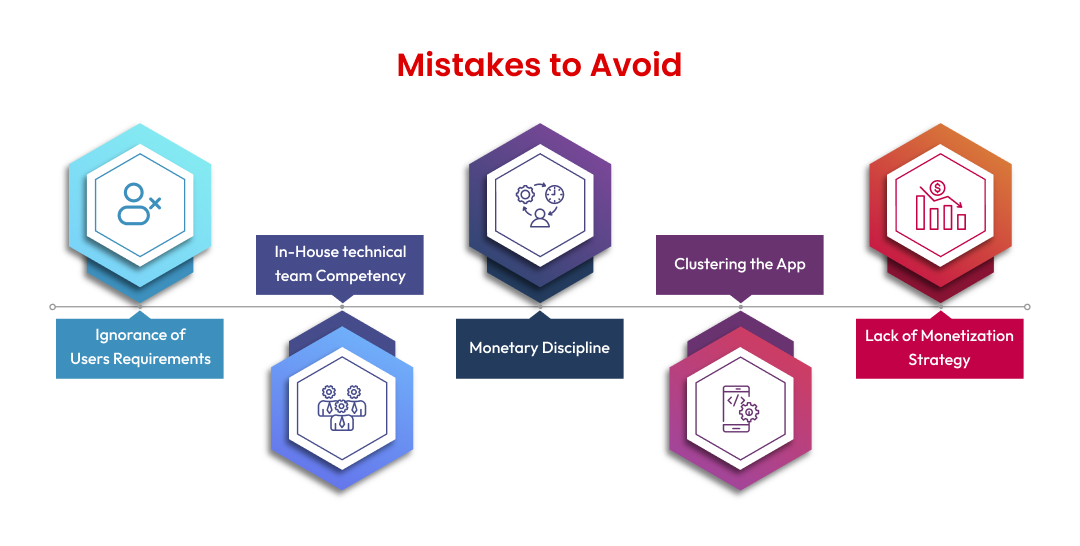
Firms’ awareness of the development of mobile apps has grown, and they are ready to assimilate the latest technology in its features and functioning. Along with enthusiasm, it’s important to thoroughly examine the various errors that are either missed or ignored but could hurt your mobile site. A few common ones are:
Ignorance of users’ requirements:
The most common and profound mistake business owners commit is a lack of knowledge of customers’ needs. The time and money spent on the product gain no popularity as it does not benefit the user. Therefore, before beginning mobile app development, conduct extensive research on the app idea and user expectations of the app.
Monetary discipline:
Many businesses face the reality of overspending on mobile app development. As maintenance expenses increase, they struggle with limited or lack of funds.
To be on the safer side, spending time creating a detailed budget plan and adhering to it is always appreciated.
Since forecasting the future is not feasible, always allocate funds for an emergency.
In-house technical team competency:
Many firms rely on the in-house technical team to build the application. As work progresses, the management realizes their present team needs sound technical know-how. Either they need to gain the experience to address the problem, or they are indulging in many day-to-day tasks. Thereby allocating limited time towards app development.
Clustering the app:
The multi-vitamins that enhance your application exposure is ‘User-experience’. Emphasize using only relevant features usable by an average user. Including too many elements will complicate the user experience.
Further, adding many features lengthens the loading time for the programmer, slows down the app’s overall performance, over-spending scarce resources, and delays the launch of the mobile app in the market.
Lack of monetization strategy
Developing a mobile app is expensive, incurring costs from production, outsourcing and post-deployment. A demonetization model must be selected before investing in the app to cover expenses and make a profit.
Paid advertisements, subscriptions, in-app purchases, and many other monetization methods are a few of the well-known ones.
How to develop a mobile application?
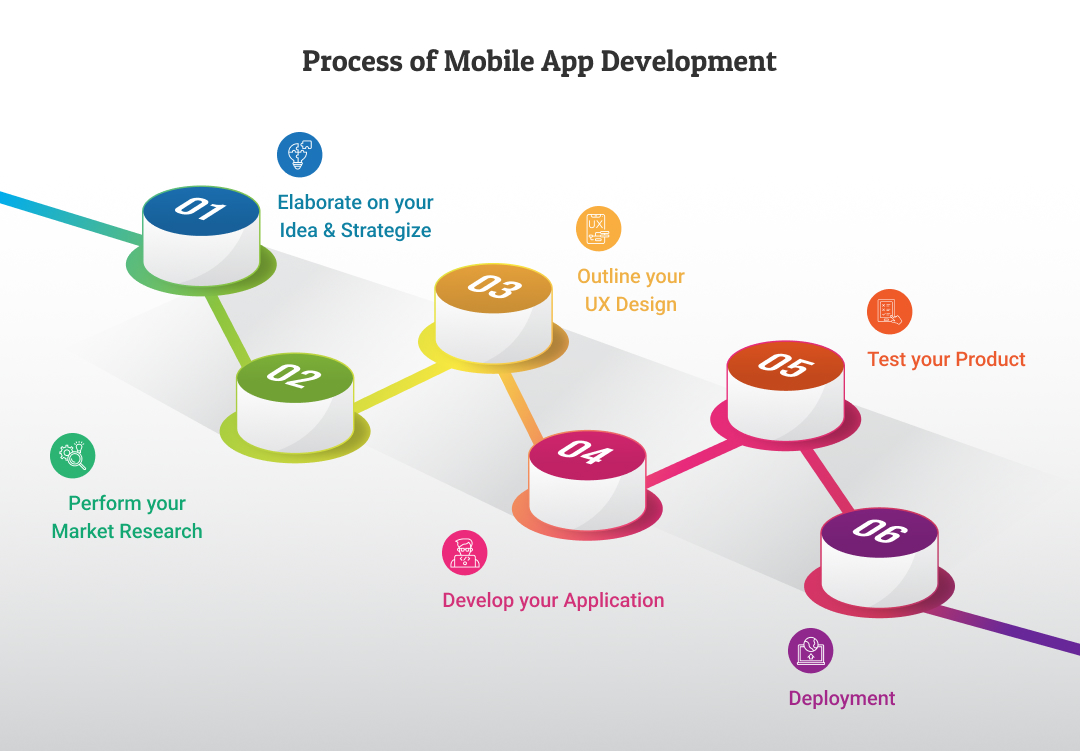
Let us discuss the various stages of mobile application development.
Elaborate on your idea and strategize:
The initial questions that one needs to ask oneself are as follows:
- What is the mobile application going to accomplish?
- What are its objectives?
- What problems of the customers is the mobile app going to resolve?
- What is the latest technology included in the app’s features?
- What is the cost of the mobile device, and will it be attractive to a cost-conscious society?
- Will the budget be sufficient for the mobile app we intend to develop? Or is additional money from promoters required?
- In that case, how do you attract investors and determine whether the money is collected through debt or equity?
- How will you develop the app—through an in-house team or by outsourcing it?
The initial strategy needs to be concrete and always give the necessary ‘foot space’ to make a milder deviation in the peripheral, but the core needs to remain the same to branch out.
Perform your market research.
The idea you finalized on paper needs to take shape to perform well in the market. Start with your preliminary study because there aren’t many opportunities to introduce a novel idea to the unchallenged market.
- Identify your competitors and their strengths and shortcomings.
- Define your target audience and how your product will add value.
- What distinguishes your product from its competitors enough to make it successful?
- Which platform should you pick to release your app to get the most users?
- What is the marketing strategy adapted to promote your app?
Market research is imperative to having the initial breakthrough about the viability and utility of the product. There is no point in developing a product where sufficient players try to carve out their niche in an already saturated market. With market research, there is a saving of funds and time.
Outline Your UX Design
The mobile app design is the foundation for the entire application. Even the best-functioning mobile application will fail if the design does not support the product. Start thinking about the app and how it needs to appease its audiences. Either start drawing rough sketches or hire a designer to create the wireframe and see how the app will function.
The ideal “user experience” is the only thing that can build a success story. Make sure the user experience is fluid to make switching between different devices and screens easier.
- Construct a roadmap to demonstrate how each screen is connected to the next.
- Think from the user’s perspective and how this mobile app needs to be beneficial.
- Identify the variations between the creation of web applications and mobile application development to check the overlaps.
- The users are the king, and they script the success of your product. Therefore, make the ‘user experience’ the core.
During this state, create photocopies of the application from the wireframe before you build the fully functional application.
Develop your application:
The concept takes shape, including front-end, back-end, and API technologies.
Reiterate the points:
- Which alternative to product development is the best?
- Choose the greatest technical team you can.
- Choose a project manager who is proactive and knowledgeable.
- Set goals and milestones for your timetable.
- Be quick to react and adaptable to making minor changes as necessary.
The development method is carried out using your methodology. Utilize cross-platform development tools and create a single version of the app that is compatible with both operating systems. Alternatively, you can build two distinct applications to support iOS and Android.
- A straightforward application with basic features and functionalities helps optimize cost and time.
- A sophisticated application will require deploying advanced technological features like GPS functionality, real-time communication, and much more. It impacts your timelines for release and takes a large portion of your budget.
Test your product
Before launching the product, ensure it functions smoothly. Before the application reaches the mobile application stores, testing helps find and resolve bugs, glitches, and other irregularities.
- The optical method is quality assurance testing at each phase of development.
- Test the application’s compatibility on all the platforms (iOS, Android, and hybrid) and various devices like (smartphones and tablets).
- Perform tests with actual product users, gather constructive feedback, and make modifications.
Despite all the testing, there is always the chance that a mistake will occur during the procedure. Be vigilant and well-equipped to address them quickly.
Deployment
The deployment stage is critical for your product to make an impression on the user.
Some points to keep in mind are:
- First, launch a beta version of your app just a few short weeks before its anticipated launch to check how users respond to it and work out last-minute issues.
- Create a developer account if the product is placed in an app store.
- Ensure your app adheres to the app store submission guidelines Google Play Store Guidelines | Apple’s App Store Guidelines
- Hold back some features of the mobile app and, after further development, launch them in an updated version at the earliest.
Post-App Launch Activities
The user experience determines whether an application succeeds or fails in its final lap. It also entails upkeep, innovation, answering consumer questions, looking over customer suggestions and input, and, eventually, the expansion of the product.
To whom should you entrust your app development process?
After understanding the process of mobile app development, now the Management’s most difficult but critical decision is whether to build the app in-house or hire an app development firm. The choice becomes challenging as it depends upon several variables, including a time frame, money, and technical Infrastructure.
Let us weigh the merits from the opposite side of the spectrum.
Benefits of in-house mobile app development:
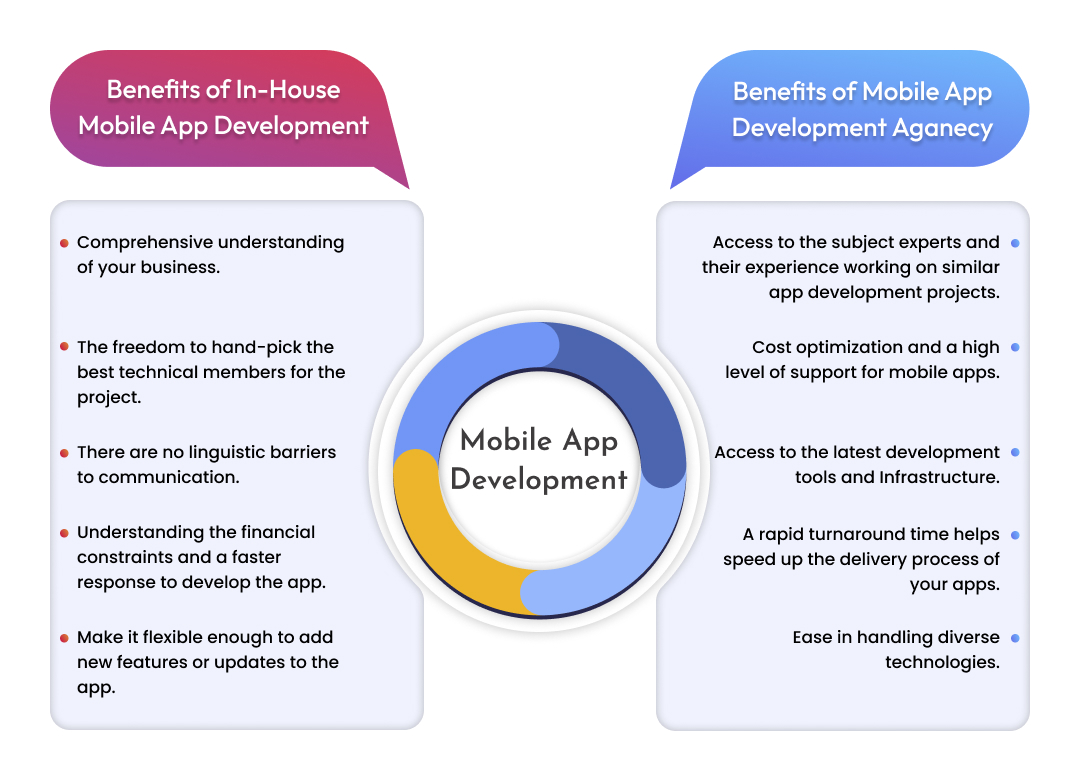
- Comprehensive understanding of your business.
- The freedom to hand-pick the best technical members for the project
- There are no linguistic barriers to communication.
- Understanding the financial constraints and a faster response to develop the app
- Make it flexible enough to add new features or updates to the app.
Benefits of Mobile app development agency:
- Access to the subject experts and their experience working on similar app development projects.
- Cost optimization and a high level of support for mobile apps.
- Access to the latest development tools and Infrastructure.
- A rapid turnaround time helps speed up the delivery process of your apps.
- Ease in handling diverse technologies
How can iSQUARE help in your app development?
Mobile application development is critical to every company’s marketing plan, from start-ups to well-established businesses. Due to the demand, it is better to approach well-known businesses in their respective industries.
Due to the underlying reasons, iSQUARE has established itself as a reputed mobile app development company.
- Experience gained through creating on-demand mobile apps and knowledge of the current market trends.
- Making an interactive and engaging user design by focusing on the UI/UX design process.
- Our portfolio is a testament to our working experience in diverse industries, with various case studies showcasing the challenges and our effective solutions to resolve them.
- Prioritizing the maintenance of the product after launching it and adding new features
- Our confidentiality clause remains intact even after the project is completed.
- Deliver a satisfactory product to our customers suiting their budget.
Please call us at +91 8012005000 if you want to know more about our services and products.













